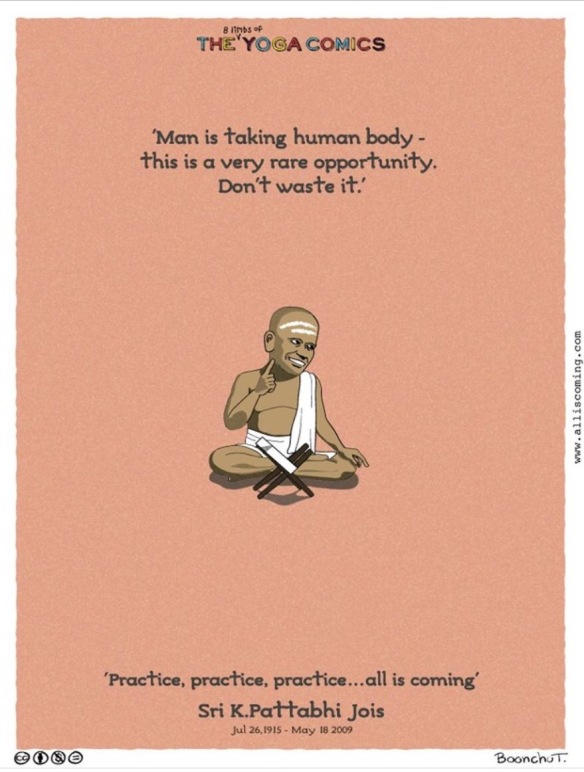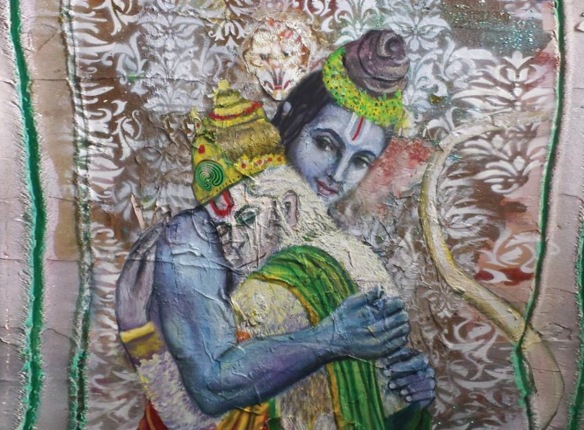 “Why so serious?”it’s one of my favorite Guruji quotes. I never heard Gurugi say this, nor did I ever get the pleasure of meeting him, I started right after he had given his last breath in this life, but most certainly his teachings live on. I feel in many ways, by those I’ve studied with, who knew him, and loved him, that they have shared so much more than just his methodology, but his spirit, his joy, his devotion to studying, most famously, in his simple yet wise message- “Do your practice and all is coming.”
“Why so serious?”it’s one of my favorite Guruji quotes. I never heard Gurugi say this, nor did I ever get the pleasure of meeting him, I started right after he had given his last breath in this life, but most certainly his teachings live on. I feel in many ways, by those I’ve studied with, who knew him, and loved him, that they have shared so much more than just his methodology, but his spirit, his joy, his devotion to studying, most famously, in his simple yet wise message- “Do your practice and all is coming.”
Yet, what I can’t answer is, when is all coming? Is it when you finally get a bind in marichasana D or supta kormasana? Perhaps kapotasana or karanvandasana? Maybe, maybe not, because as Guruji so wisely said, “Yoga is an internal practice. the rest is just a circus.” In other words whatever satisfaction you get or the physical struggles you may overcome to master an asana physically, as great as it may feel to get there, it’s just a tool, though potentially a powerful one, to initiate the inner workings of what yoga can bring to you, if you let it.
Ideally, with the guidance of a teacher, this journey unfolds. And though the methods are all laid out, structured, set sequences timed to breath, passed down from teacher to student, as taken from Sharath’s Ashtanga Yoga Anusthana parampara is:
An uninterrupted succession, a direct and unbroken transmission of knowledge from a teacher to his or her student
The beauty and complexity of truly teaching and learning Ashtanga is the individualized approach. This is the trickiest part of parampara. The part where it potentially gets lost in translation, where students and even teachers can get confused, frustrated, compare, wonder what it’s all for, or ask the dreaded question, when will I be able to do ______? Or why haven’t I lost weight, or I’m sore all the time, I used to feel good, but now I can’t sleep, or a million other issues that have come up in practice or just in the happenstance of living. The part where we learn another famous quote, “its 99 percent practice, 1 percent theory.”
The crap shoot is the unique nature of each person. Just as in parenting my three kids, I’m the same, but they are not. I chuckle thinking about each saying to me, that isn’t fair or you let them do xyz, or some other comparison in the grayer areas of parenting unlike hard fast rules like seat belts, but nothing is one size fits all. They have unique personalities, different strengths and weaknesses, temperaments, and all that goes along with that. In taking that a step further, I can offer each the same basic guidelines, securities and structure, but they will only understand and grow, each to their own capability. So one might be a math tutor and one might need a math tutor, one may be gifted at music another at writing. My raising them, exposing them to similar stimulus, sending them to the same schools, did not make them cookie cuts of each other or me with the same hopes and aspirations beyond the basic foundation of knowing I love them, teaching them to be compassionate in life and passionate about what they do and trying their best. Though I wish I could, ultimately I can’t make them happy or fulfilled, only they can do that for themselves, but I promise to be there number one mentor, fan, and disciplinarian and love them unconditionally.
This perspective also holds in parampara. We learn the structure, the breath count, the asana, and potentially much more, but like anything, there are pieces that teachers will place more or less importance upon based on their own personality. As an example, some will hold you at Mari D until you can get it on your own, others may move you forward once you can get the bind with an assist and someone else may let you move forward regardless of the bind. None are wrong, that distinction is important. Honestly, all those instances could even happen under the tutelage of the same teacher, because the practice is individualized, each person has different capabilities. “Body is not stiff. Mind is stiff.”
So yes it can seem confusing or frustrating, and teachers like parents are flawed humans making mistakes along the way. It’s easy to get caught up in the attachment, in ego, in wanting, because we are human. The danger arises when we no longer question our motives, and forget to take decent assessments of the nobility of our objectives. The wisdom comes when we can recognize it when we go off track, because at some point we all screw up, and when we do, to have compassion instead of self loathing or worse denial. Forgiveness of ourselves, our teachers, our students, for everyone. So, yes, why so serious, when you can be light to find the light inside.
There is no perfection, not with Guruji, now with Sharath or any other master teacher, just ideally a purity of intention to do no harm and like a parent need to grasp a teacher is only there to facilitate. Ultimately the choices made are up to the individual. Some come to this as excellent parrots able to perform asana or recite Sanskrit seemingly without effort, but it’s never about the natural physical or intellectual capability, it’s the ability to see and work through the struggles, the doubts, the effort, the intentions all without judgement, without comparison, without attachment to the outcome, instead to try it with a loving heart and humor, just trying your best. Remember, as Guruji said, “Yoga is possible for anybody who really wants it. Yoga is universal…. But don’t approach yoga with a business mind looking for worldly gain.” Approach it with devotion and light.






